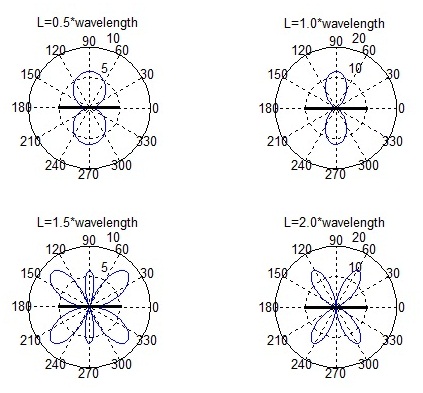In the previous post we plotted the E-field of a half wave dipole. We now turn our attention to higher antenna lengths such 1,1.5 and 2.0 times the wavelength. The E-field pattern is a three dimensional pattern, however, we only plot the E-field in a 2D plane along the axis of the dipole.

It is observed that as the antenna length is increased from 0.5*wavelength to 1.0*wavelength the antenna becomes more directional. However, as the length is further increased from 1.0*wavelength to 1.5*wavelength and 2.0*wavelength sidelobes begun to appear. These sidelobes are an unwanted phenomenon in a typical telecommunications application. When the antenna is placed vertically (shown horizontal in the above figure) it radiates uniformly along a horizontal plane and would provide coverage within a circular cell (not for 2.0*wavelength where there is no radiation at 90 degrees).
Author: Yasir
More than 20 years of experience in various organizations in Pakistan, the USA, and Europe. Worked with the Mobile and Portable Radio Group (MPRG) of Virginia Tech and Qualcomm USA and was one of the first researchers to propose Space Time Block Codes for eight transmit antennas. Have publsihed a book “Recipes for Communication and Signal Processing” through Springer Nature.
One thought on “E-field of a Dipole Antenna”
-I agree. We have used this type of anetnna on field day with great results. Long wires as well with a tuner, sometimes up only 20-feet.